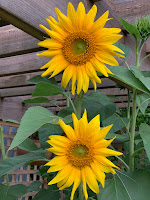Seven couples here on the Sunshine Coast have got together to support each other in dealing with
aphasia, a communication disorder that affects a person’s ability to use language to communicate. We're calling ourselves the
Sunshine Coast Aphasia Group, and we met earlier this year when we participated in that
clinic, organised by Sunshine Coast Speech Pathologists, which I've written about earlier.
Aphasia most commonly occurs as an after-effect of stroke. For five of the seven couples in our group, that is how one partner acquired aphasia – through damage to the language-generating part of the brain as a result of one or more strokes. But other events may also cause aphasia. One person had an accident which resulted in damage to that part of the brain that controls language. And of course my own husband has a rarer version –
primary progressive aphasia – in which the language-generating areas of the brain begin to deteriorate for no apparent reason. Unlike with Alzheimer’s and other forms of dementia, primary progressive aphasia affects only one part of the brain. So as is the case with other aphasia sufferers, my husband has not lost his intelligence or personality. But he is greatly frustrated in his ability to express himself and must struggle endlessly to make himself understood.
Aphasia can take many forms. In my husband’s case, speaking and writing are greatly affected, but he can read quite well. As with many aphasia sufferers, he can also sing along to any song for which he has the words! But the simplest commercial transaction in a shop is a major challenge. That’s because his ability to work with numbers has also deteriorated. So even though he once managed large budgets for theatrical productions, now he has difficulty buying a newspaper, and answering the telephone requires him to read from a printed script.
Aphasia presents differently in every person, however. Some people cannot read at all; many cannot write. Not surprisingly, people who have aphasia may withdraw from contact with the world, or even from family and friends, unless they receive the right kind of support. Often they must learn to engage with the world in a new way. Hence, initiatives like the Sunshine Coast Aphasia Clinic are a godsend for aphasia sufferers, and for their carers, who have a vital role to play in helping maintain the family’s quality of life.
Our group was pretty special in that it happened to include seven couples who were all eager to make contact with others who were struggling with this affliction. For most of us, this was the first time we had the opportunity to share our stories of living with aphasia, and to learn how others cope with the daily challenges we all face. It’s very common for people who come into contact with an aphasia sufferer for the first time to assume the aphasic person is intellectually subnormal, because of the difficulty persons with aphasia may have in expressing themselves. But among ourselves, we find we can relax and have some fun with our peers without being judged.
As our eight 2-hour sessions came to an end, the group decided we would continue to meet socially once a month in a public place. Anyone who is living with aphasia would be welcome to join us. These will be social gatherings, not meetings, but the Australian Aphasia Association, which some of us have joined, will add our group to their list of regional aphasia support groups that is circulated in the organisation’s newsletter,
Aphasia Link. That may help other persons with aphasia and their partners or caregivers to link up with us.
The
Sunshine Coast Aphasia Group held its first coffee morning on Monday, 12 July. We had a great morning and were still lingering in the cafe's outdoor eating area at midday! If you have aphasia, or are supporting someone with aphasia, or even if you'd just like to know more about aphasia, you are welcome to join us at our monthly coffee mornings on the 2nd Monday of every month at Banjo's (Woolworths Complex, 50 Plaza Pde, Maroochydore) at 10 am. It's not necessary to book, but if you want more information you can contact me by email (chartreuse at ozemail com au). I can then give you my telephone number, if you'd like to speak to me or another member of our group before coming along.

Allen and I are pictured here with two Queensland Health speech pathologists (Cathy on the left; Ruth on the right), and other members of our new Sunshine Coast Aphasia Group, whose friendship and camaraderie A and I value greatly. (Cathy and Ruth were two of the four 'speechies' who organised and facilitated the 8-week clinic that initially brought us all together.) I have not shown faces out of respect for people's privacy. But we are continuing to meet every month, and others are welcome to join us!
If any readers would like more information about aphasia, or about our monthly social gatherings in Maroochydore, please contact me at "chartreuse at ozemail com au" (making the necessary symbol substitutions for 'at' and adding in the full stops.) I'll get back to you then with my personal contact details.























